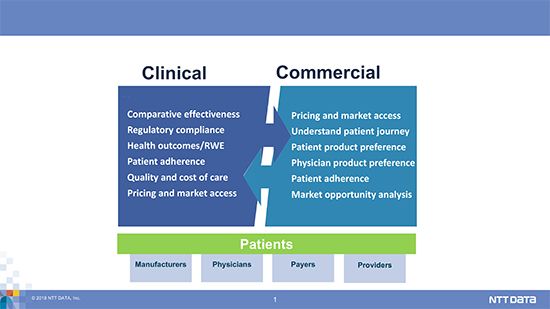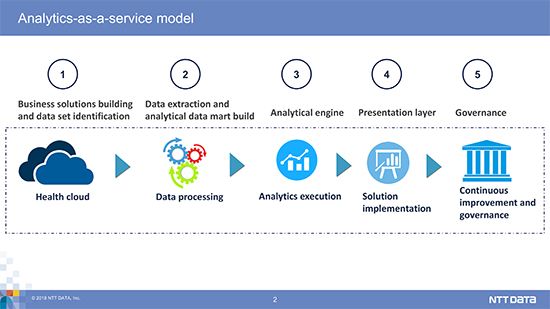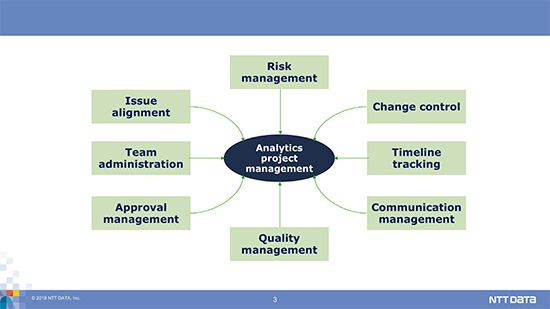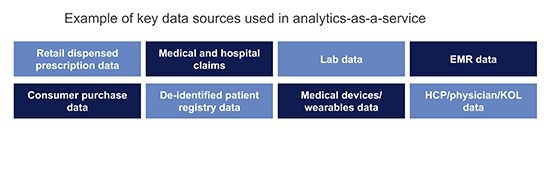Enabling a Single Integrated View of Critical Real-World Data with Analytics as a Service
Analytics as a service can provide critical accelerators for the commercial transformation program at a life sciences organization, writes Himanshu Jain.
Life sciences companies today are on a dynamic journey to transform into diversified, specialty biopharmaceutical giants with a focus on precision medicine and personalized treatment. The success of this transformation depends on several key forces in the healthcare environment, including:
• Evidence-based market entry/access, which requires firms to provide targeted evidence throughout the drug lifecycle for continued access to payer formularies
• The acceleration of consumerization in healthcare, which prompts patients to take on more of their healthcare costs yet also enables them to make more decisions for their treatment
• Rapidly emerging competition in complex specialty markets, which currently have over 1,200 specialty and rare disease drugs in Phase 2 and Phase 3 trials
• Evolving delivery and payment models, which require pharmaceutical companies to rethink the traditional approach to sales targeting and customer segmentation
Organizations need a sound foundation to navigate industry challenges and enable intelligent, proactive decision-making - built on components, such as a single, integrated patient, payer and practitioner data repository, to support a wide variety of healthcare applications and analytics. This is where clinical and commercial insights come together to create a more complete view of the patient experience (see Figure 1).
Figure 1: The convergence of clinical and commercial data for an integrated data repository

Additional data, such as genomic data, lab data, biomarkers and wearable data, can then be integrated to the data repository after the de-identification process. With robust, flexible and cloud-based business intelligence solutions, as well as exceptional customer service and consulting services, organizations can easily glean new, innovative insights from their existing data.
Why analytics as a service?
Analytics as a service is an analytical platform that uses a cloud-based delivery model and includes various tools for data analytics. Users can configure these tools to efficiently process and analyze huge quantities of data.
Figure 2: Example of key data sources used in analytics-as-a-service

From medical claims to de-identified patient registry data and consumer purchase data, the data sources used in an analytics-as-a-service model (see Figure 2) can be complex and difficult to standardize and integrate. A health cloud platform enables organizations to establish strong inbound data management, with predefined and customized internal key metrics and alerts for data collection.
Data collection can be monitored on a daily or weekly basis to ensure all expected files are received from each data supplier and the quality is intact. It’s also critical to enable an exception management quality control system that focuses on proactively identifying data inconsistencies.
Data security and privacy are equally important when implementing an analytics-as-a-service solution. As part of the HIPAA de-identification process, data records need to be prepared for transmission to an organization’s health cloud platform by either removing or encrypting personally identifiable information. Data fields are encrypted using the Advanced Encryption Standard (AES) specified by the National Institute of Standards and Technology (NIST). Data scrubbing routines are also used in combination with the AES encryption methodology to consistently and meaningfully make insights across disparate data sources.
Figure 3: Analytics-as-a-service model

A health cloud platform provides state-of-the-art infrastructure that’s scalable and flexible, with virtually unlimited capacity. It houses an information store that can integrate claims, electronic medical records (EMRs) and wearables data with other industry/public domain data sources. This consolidated information store enables data exploration and knowledge discovery (via advanced analytics), providing immediate access to key performance metrics, data visualizations and predictive analytics that enable rapid, informed decision-making.
Data processing selection provides a web services/messaging interface externally, through which data is acquired from the health cloud. To provide the flexibility needed for diverse data sources and protocols, a modular structure is critical, with components that implement widely recognized enterprise integration patterns. This helps streamline the process by making sources more ETL (extract, transform, load) compatible; it transforms and loads the data so that it’s ready for analysis.
To process huge volumes of data, it’s also essential to utilize an analytics data mart, so that different processing algorithms can be implemented and executed in parallel. This data extraction and restructuring layer acts as an interface between the health cloud and the analytics engine. The analytics engine and custom-built presentation layer are, in a sense, the most crucial parts of the platform. This is where all the analytical processes and data visualization reside.
Figure 4: Success metrics for analytics-as-a-service model

For continuous governance and improvement, subject-matter experts, internal teams and program managers can perform the following functions:
• Risk management: Identify possible risks and prepare a mitigation plan; create risk tracking templates and manage action protocols
• Issue alignment: Create a centralized system to log issues, assign owners and track resolution
• Timeline tracking: Track project status and provide weekly updates
• Approval management: Establish decision-makers and track approval/decision-making
• Team management: Maintain key members based on analytics needs and track team utilization
• Change control: Manage change requests and possible impacts on timelines
• Quality management: Establish key quality checks, standard operating procedures and quality control documents
A major advantage of the analytics-as-a-service model: using advanced analytics to generate detailed reports in a matter of minutes, and innovations in machine learning and predictive analytics that take human modeling out of the equation. That means faster analysis with tremendous accuracy; whether it’s thousands or millions of rows of data, it’s possible to generate a report that’s fast, accurate and meaningful.
Although not an exhaustive list, here are some examples of commercial analytics and reporting that can be generated using analytics as a service:
- Source of business analysis:
• Understand the underlying trends behind prescription share and volume patterns
• Calculate loss and gains while comparing results with the competition
• Calculate the usage of drugs across different medical conditions for competing brands
- Market performance analysis:
• Manage brand performance for specific markets or therapeutic classes
• Understand market share using data from competitors (by market/therapeutic area)
• Perform volume analysis for key clusters
- Physician targeting:
• Analyze volume contributors for any brand, creating a specific segmenting message and achieving greater sales for specific clusters
• Forecast volume-based prescriber segments to optimize the salesforce
- Market driver analysis
• Understand key drivers among the metrics such as sales rep quality and sales rep tactics
• Determine which metrics are most influential on physicians' intent to prescribe and how the brand performs on these metrics, compared to competitor products
- Rejection/reversal analysis:
• Define key attributes for reversals and rejections
• Identify top payers against competitor brands
• Segmentation by payer/patient demographics
• Analyze approval, rejection and reversal at the payer level
Analytics as a service can provide critical accelerators for the commercial transformation program at a life sciences organization. This model must be supported by a strong delivery management team that also leverages a global team of data scientists and analytics experts to improve the efficiency and effectiveness of data management and, ultimately, generate insights. Data management and governance are critical; proven processes and tools must be in place to fully integrate and maintain data. Once implemented, a program management and transition team needs to manage reporting and monitoring procedures, and risk management, configuration management and change management to keep the analytics-as-a-service platform on track.
Himanshu Jain is Business Consulting Director, Life Sciences and Healthcare Strategy, NTT DATA Services.
Is Artificial Intelligence a ‘Product’? Products Liability Implications for AI-Based Products
April 10th 2025As the physical products we use evolve to become increasingly complex, traditional products liability frameworks may not always fit to provide remedies for harm that can result from using novel product types.